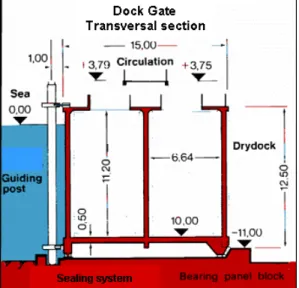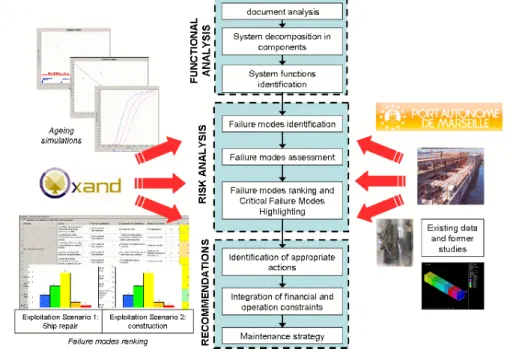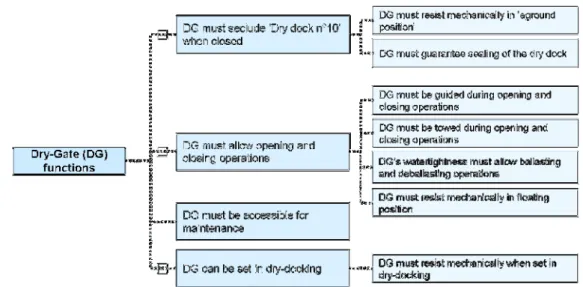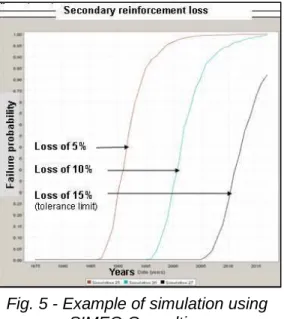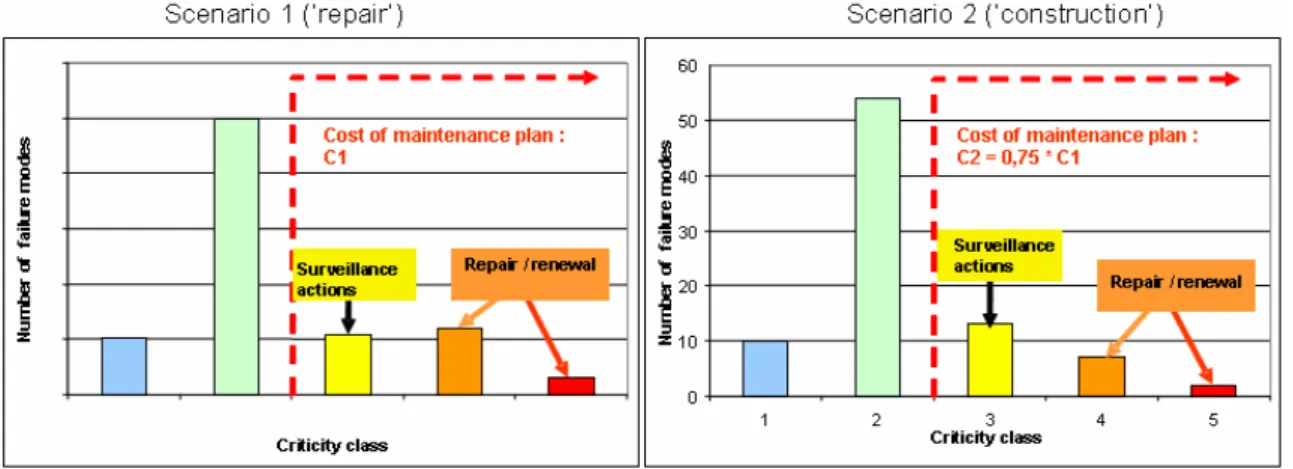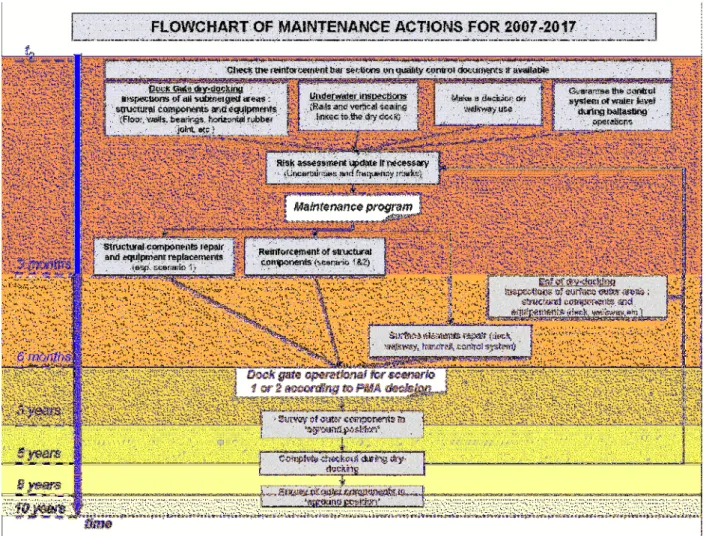HAL Id: hal-01008851
https://hal.archives-ouvertes.fr/hal-01008851
Submitted on 26 Aug 2019HAL is a multi-disciplinary open access archive for the deposit and dissemination of sci-entific research documents, whether they are pub-lished or not. The documents may come from teaching and research institutions in France or abroad, or from public or private research centers.
L’archive ouverte pluridisciplinaire HAL, est destinée au dépôt et à la diffusion de documents scientifiques de niveau recherche, publiés ou non, émanant des établissements d’enseignement et de recherche français ou étrangers, des laboratoires publics ou privés.
Risk analysis to support operation and maintenance of
an ageing dock-gate for the Port of Marseille Authority
S. Crouigneau, L. Bourdon, Y. Billard, J.L. Person, Franck Schoefs
To cite this version:
S. Crouigneau, L. Bourdon, Y. Billard, J.L. Person, Franck Schoefs. Risk analysis to support operation and maintenance of an ageing dock-gate for the Port of Marseille Authority. Proceeding of 1st Inter-national Conference on Applications Heritage and Constructions in Coastal and Marine Environment, 2008, Lisboa, Portugal. �hal-01008851�
Risk analysis to support operation and maintenance of an ageing
dock-gate for the Port of Marseille Authority
Sophie CROUIGNEAU1, Loïc BOURDON2, Yvan BILLARD3, Jean-Luc PERSON4, Franck SCHOEFS5
1 Consultant Engineer, OXAND S.A, 36 bis avenue Franklin Roosevelt, F-77210 Avon, FRANCE, sophie.crouigneau@oxand.com
2 Consultant Engineer, OXAND Canada Inc., 1010 rue Sherbrooke Ouest, Bureau 1805, Montréal
(Québec) H3A 2R7, CANADA, loic.bourdon@oxand.com
3 Experienced Consultant, OXAND S.A, 62 bvd Niels Bohr, BP 2132, F-69603 Villeurbanne,
FRANCE, yvan.billard@oxand.com
4 Technical Prime, Port Autonome de Marseille, 23 place de la Joliette, F-13226 Marseille,
FRANCE, Jean-Luc.Person@marseille-port.fr
5 Assistant Professor, University of Nantes, Institute in Civil and Mechanical Engineering (GeM),
UMR 6183, CNRS, Faculté Sciences et Techniques, 2 rue de la Houssinière, F-44000 NANTES, FRANCE, franck.schoefs@univ-nantes.fr
Abstract
The dry dock n°10 is a strategic infrastructure of the Port of Marseille Authority: its dimensions (465 x 85 m) place it among the biggest dry docks in Europe. Built in the seventies, it is isolated from the sea by a dock-gate in prestressed concrete. Faced to the ageing of this dock-gate, the Port of Marseille Authority wished to make the most of its knowledge in order to assess the feasibility of two considered operation scenarios: use the dry dock for ship repair or for building new civil engineering structures.
In this context, OXAND and the Port of Marseille Authority worked together so as to obtain formal and objective decision-making indicators. These indicators took into account the different operation stakes of the dry dock (security, availability), the condition diagnosis and the ageing prognosis of components and facilities of the dock-gate, along with adapted maintenance actions and related costs.
The risk analysis methodology used for this study allowed (1) to characterize the risks linked to each foreseen operation scenario, (2) to identify the most appropriate actions to control these risks, integrating operation constraints (e.g.: need to put the dock-gate in dry dock), (3) to rank these actions regarding their cost/benefit ratio and thus (4), to build a maintenance plan.
1. Introduction
1.1 Context and objectives
The Port of Marseille Authority owns one of the biggest European dry docks, called ‘dry dock n°10’. This structure was built in the 70’s and aimed at receiving huge oil tankers for repair. Because of the decline of oil trade, this impressive dry dock stopped being operated around 2000. Facing the increasing size of container ships, the Port of Marseille Authority recently thought of reusing it. The dry dock n°10 can be isolated from the sea than ks to a dock-gate made of prestressed concrete. This dock-gate consists of a massive box divided into compartments and can be easily operated by filling or emptying those compartments with seawater. When the dock-gate is filled (about 7 m of water inside), it behaves like a gravity dam and can be used to close the dry dock (see figure 1 ‘aground position’). When it is empty (with a level of only 2 or 3 meters of seawater inside), it floats and can be quickly moved, dragged by an appropriate pulling system.
Fig. 1 - ‘Aground position’ of the dock-gate
Willing to start operating the dry dock again, the Port of Marseille Authority wanted to know the risks that might be generated by the dock-gate re-use as well as the actions to guarantee operation safety and profitability. OXAND was thus mandated to assist the port in the development of an operation and maintenance strategy of the dock-gate for the next ten years.
Objectives of the port were to obtain formal and objective decision-making indicators, based on a technical and financial global approach, considering two different operation scenarios:
Scenario 1: the dry dock n°10 is exploited for shi p repair, which implies a high frequency of the dock gate use, with a minimum of 120 opening-closing operations a year;
Scenario 2: the dry dock n°10 is exploited for bui lding new civil engineering structures, which implies a lower frequency of the dock gate use, with about 10 operations a year.
1.2 Risk analysis: a global approach
Marine works like ships or offshore structures have been more and more subjected to risk analysis over the last decade. More recent studies, also based on risk analysis, deal with coastal structures like wind turbines, facilities for coast protection (Sorensen et al., 2004), survey optimization of harbours (Billard et al. 2006, 2007) and harbour monitoring for reliability (Yanez-Godoy et al., 2006). Risk analysis approach has also appeared during decommissioning works (Kroon, 2004): it clearly stands now as a robust and well-experienced methodology to optimise infrastructure management.
The methodology used by OXAND to answer PMA’s needs consisted in a FMECA (Failure Mode Effect and Criticality Analysis) of the whole system ‘Dock Gate’. This approach begins with a functional study of the system (integrating all its structural components and equipments), goes over a thorough identification and quantification of the potential failure modes and ends with a prioritisation of appropriate actions.
This methodology was adapted for the specific needs of the Port of Marseille Authority, as shown on the figure here below:
Fig. 2 - Risk analysis methodology applied to the dock-gate
2. Experimental Program
2.1 Functional analysis
2.1.1 System decomposition in components
The first step of the study is to split up the system into its components according to their environment, solicitation, geometry or material.
This aims at being exhaustive in the later identification of potential failure modes. The first degree of decomposition (‘zoom 2’) is described on figure 3; the decomposition includes structural elements (walls, floor and deck) so as equipments (handrails, sealing, etc.).
Each component plays a specific role in the functioning of the dock gate. The next step is to define the expected functions of the dock gate and to link them to one or several components.
2.1.2 System functions identification
Expected functions of the Dock gate were identified as shown on figure 4:
Fig. 4 – Identification of the expected functions of the Dock Gate (DG)
Those functions imply resistance to following environmental conditions:
Normal operation loadings: dead load, wind, stream, hydrostatic pressure in floating and aground positions, service loadings (overloads due to materials handling, vehicles), steerage stresses (warping, frictions…);
Accidental loadings : flood overload, leaks, ship collision, swell of Labé, exceptional water level (cyclone …), seism, wrong position on bearings;
Environment: frost, temperature variations, humidity, oxygen/carbon dioxide, chlorides, sulphates, aggregate reactivity, sulphate ions action, chloride ions action, etc.
2.2 Failure modes identification and assessment
2.2.1Identification of failure modes
The exhaustive list of potential failure modes is built thanks to a crossing between the components and the expected functions of the dock gate. For each component, an analysis of the different causes which could lead to a failure of the associated function is carried out.
For example, the components ‘walls’, ‘floor’ and ‘deck’ obviously take part in the function ‘the dock gate must resist mechanically in aground position’. The ‘walls’ could lead to Dock gate collapse if they couldn’t resist the loadings anymore (ex: loss of prestressing strength due to delayed effects or loss of reinforcement steel due to corrosion), or if ‘aground’ loadings had to increase (e.g.: operation mistake). We have identified here 3 different failure modes.
For the Dock Gate risk analysis, we identified 86 different potential failure modes taking into account all components and all expected functions.
Those failure modes are then quantified to find out the critical ones. 2.2.2
Failure modes assessment: definition of criticality
In this study, the criticality of failure modes was calculated with three parameters: The frequency of a failure mode, which means its probability of occurrence,
The severity of a failure mode, which means its level of consequence on the owner’s stakes (i.e. the Port of Marseille Authority),
The uncertainty on the allocation of the frequency rate (in case of missing information for example).
To assess the frequency of failure modes concerning mechanical resistance, OXAND calculated the different safety margins (for each component) and compared them to the residual estimated resistance. OXAND used among others the SIMEO™ Consulting software to take into account the ageing mechanisms (especially carbonation and chloride attacks). This software enables numerical simulations of ageing structures with physicochemical and mechanical characteristics of materials. The input data are taken from the document analysis (calculation notes, structure description, etc.) such as materials parameters, environmental conditions and detected defaults. Uncertainties linked to input data can be integrated thanks to a probabilistic module.
To assess the severity of failure modes, different consequence levels were qualified regarding what could be perceived as minor, slight, serious or major for the port. This has been formalized in a severity grid developed in collaboration with the port. Two major stakes were considered: the safety and the availability of the dock gate operation.
The criticality assessment will allow quantification and thus a ranking of identified failure modes.
3. Results and discussion
3.1 Failure modes ranking
The failure modes quantification resulted in overall risk profiles for each operation scenario, represented as follows:
Fig. 6 – Ranking of failure modes depending on criticality quantification Fig. 5 - Example of simulation using
Those figures illustrate the risk prognosis of the Dock Gate operation by 2017. Two major conclusions can be drawn:
- Only few failure modes are very critical (in red); we obtain 3 of them for scenario 1 (higher frequency of dock-gate use) and only 2 for scenario 2;
- The dispatching between the two risk profiles is very similar, and the most critical failure modes are the same for each scenario.
The most critical risks were identified as:
- Collapse of the dock gate in ‘aground position’, caused by a resistance loss of passive reinforcement, located in the wall on the dry dock side and due to corrosion (mostly chloride attack);
- Collapse of the walkway caused by resistance loss of main beams due to corrosion (chloride attack and carbonation).
The difference between the two risk profiles is mostly due to the equipments’ wearing (e.g.: horizontal rubber joints, bearings made of ekki-wood) caused by a more repeated use of the gate with the scenario 1. We will see in the next paragraph that the costs of appropriate maintenance actions also vary between both scenarios.
3.2 Identification of appropriate maintenance actions
A list of recommendations was built, based on the risk ranking; the recommended actions are defined to manage the most critical risks.
The critical and very critical risks (resp. in orange and red) were attributed roughly preventive treatment and/or heavy works (e.g.: replacement, repair, reinforcement). The significant risks (in yellow) were mainly attributed survey treatment (inspections, monitoring, etc.). When further investigation was recommended, a notice about the most suitable way to proceed was supplied (with highlighting of non destructive tests). Emphasis was put on missing data, to help reduce uncertainties of failure modes assessment.
The main differences between the maintenance recommendations related to both operation scenarios are a higher number of heavy works and equipment replacements for scenario 1, whereas the scenario 2 recommendations are more based on a survey program.
The cost estimation of maintenance actions indicates a difference of about 25% between the two operation strategies for the next ten years.
Fig. 7 – Use of risk mapping for maintenance recommendations
The recommended actions were then planned during the next ten years, integrating operation constraints.
4. Conclusion
The risk analysis of the Dock gate allowed (1) the identification of the most critical failure modes for two foreseen operation scenarios, (2) the building of suitable maintenance patterns with financial estimation, finally (3) the possibility to make a strategic decision based on concrete, objective and traceable indicators.
Regarding the identification of critical mode failures, it is important to remind that the most critical modes were globally the same for both foreseen operation scenarios. The slight differences between them were exclusively due to the frequency of opening and closing operations (the steerage frequency is ten times more important for scenario 1 than for scenario 2). Those mode failures concerned mainly equipment dysfunctions (sealing device, bearings) and structural loss of mechanical strength due to:
passive reinforcement corrosion (mainly in non permanently submerged area exposed to moisture-dry cycles),
prestressing cable corrosion,
corrosion of walkway components (due to carbonation and chloride attacks).
The conclusion of the study was: both operation scenarios are technically conceivable with suitable maintenance programs, but scenario 1 would imply maintenance costs 25% higher than for scenario 2. The port authority can make its decision regarding those argued and justified indicators and confronting them to operation opportunities.
The dock-gate maintenance pattern built by OXAND for the next 10 years can be summed up as follows:
Main recommendations are:
to check the rebar section in order to ensure that they correspond to initial plans and calculation notes (high uncertainty mark based on inspection document analysis);
to increase the indicators’ reliability of filling-water level to reduce the occurrence probability of accidental overloading;
to make a decision concerning the use of the walkway which is in very bad condition (is it really necessary? For which loads? Should vehicles be able to drive on it? Etc.);
to carry out an underwater inspection in parallel on equipments of the dry dock to assess the vertical sealing and rail conditions;
to make a complete checkout of the structure while in dry-dock to get a thorough knowledge of the components’ condition (visual inspection, gammagraphy, local sampling holes, coring).
Those investigations will allow confirming, organizing and planning the following maintenance actions:
o repair/reinforcement on the most critical structural components,
o replacement of some equipments,
after a risk profiles update (check of uncertainty and frequency marks relevancy).
Further suggestions are:
To conduct a systematic periodical survey every 3 years because of the structure’s age and marine environment;
To place the dock-gate in dry dock every five years during operation to make a complete check out and an update of risk profiles.
5.
References
Billard Y., Bernard O., Lasne M., Capra B., Schoefs F. et Boreo J., Risk analysis and reliability of repaired concrete quays. Proceeding of 10th International Conference on Applications of Statistics
and Probability in Civil Engineering, 2007, Tokyo, paper on CD-Rom, 8 pp.
Billard Y., Bernard O., Lasne M., Schoefs F., Risk analysis for survey optimisation of harbours.
Proceeding of the Third International Colloquium of the Network for Integrating Structural Analysis, Risk and Reliability, Glasgow, 2006, papers 028-109 on CD-Rom, 9 pp.
Kroon I.B., Comparative Risk Assessment for Decommissioning Decision Support. International Forum on Engineering Decision Making, Stoos, Switzerland, 2004.
Sorensen J.D., Burcharth H.F., Risk-based optimization and reliability levels of coastal structures. International Forum on Engineering Decision Making, Stoos, Switzerland, 2004.
Yanez-Godoy H., Schoefs F, Nouy A., Rguig M., Voisin D., Casari P., Extreme storm loading on in-service wharf structures: interest of monitoring for reliability updating. European Journal of Civil
